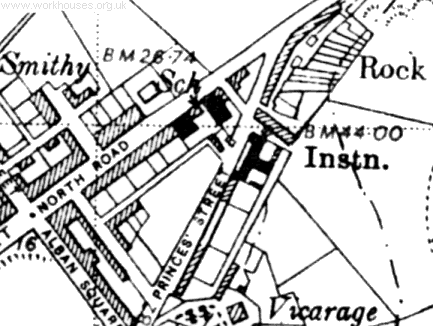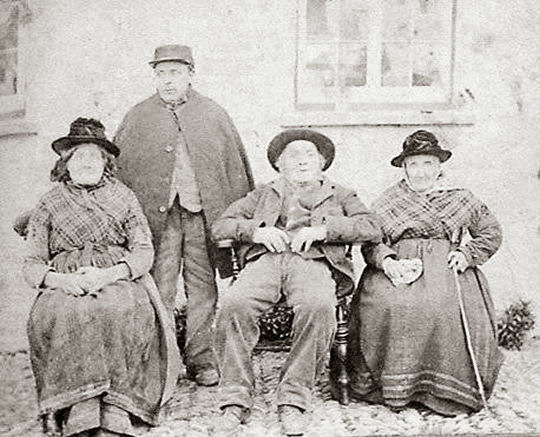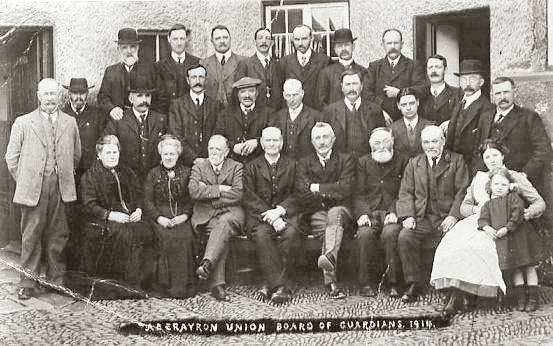Aberayron, Cardiganshire
Up to 1834
In 1784, the Dihewyd vestry resolved ‘to build a house in the church yard wall, for the poor’.
In 1790, the vestry at Llanarth agreed to build a poorhouse near Mydroilyn, where paupers were to be 'admitted and maintained, and properly employed' — making the establishment sound more like a workhouse.
After 1834
Aberayron (or Aberaeron) Poor Law Union was formed on 8th May, 1837. Its operation was overseen by an elected Board of Guardians, 16 in number, representing its 14 constituent parishes as listed below (figures in brackets indicate numbers of Guardians if more than one):
Cardiganshire: Cilcennin, Cilie Aeron, Cydplwyf, Dihewyd, Henfynyw, Llanarth (2), Llanbadarn tref Eglwys, Llandewi Aberarth, Llandisilio Gogo (2), Llanwchaeron, Llanfihangel Ystrad, Llanina, Llanllwchaiarn, Llansaintfraed and Llannon.
The population falling within the Union at the 1831 census had been 12,308 with parishes ranging in size from Llanwchaeron (population 233) to Llanarth (2,449). The average annual poor-rate expenditure for the period 1832-36 had been £3,619.
The Aberayron Union workhouse, for around 80 inmates, was built in 1838 on Princes' Street just to the east of the town. It was designed by the prolific George Wilkinson who was responsible for at least nine workhouses in Wales. The construction contract of £1,200 was awarded to local builder William Green. The building's location and layout are shown on the 1938 map below by which time the workhouse had become a Public Assistance Institution.

Aberayron workhouse site, 1938.
The restrictions of its small site gave rise to a compact T-shaped design with four small yards for the different categories of inmate (two within each arm of the T).

Aberayron from the south, 2000.
© Peter Higginbotham.

Aberayron front block from the south-west, 2000.
© Peter Higginbotham.

Aberayron from the east, 2000.
© Peter Higginbotham.

Aberayron from the south, 2000.
© Peter Higginbotham.
Stephen Thomas of Mydroilyn, near Aberaeron, has kindly contributed an old photo (below) which belonged to his grandmother and which is inscribed 'Inmates at Aberaeron Workhouse'. The man standing is said to be 'Ianto dybaco' (Ianto is a variation of the name Ifan or Evan, and dybaco is Welsh for tobacco).

Aberayron inmates, early 20th century.
Courtesy of Stephen Thomas.
Also from that period comes a 1914 photograph of the Union's Board of Guardians, together presumably with the officers of the workhouse.

Aberayron Board of Guardians, 1914.
Courtesy of Stephen Thomas.
In 1914, the workhouse was converted to a cottage hospital. In the latter part of the First World War, it provided care for injured soldiers.

Aberayron military hospital patients, 1917.
© Peter Higginbotham.
The site subsequently became Aberaeron Hospital, which closed in 2019. The buildings were demolished in 2021.
Staff
Inmates
Records
Note: many repositories impose a closure period of up to 100 years for records identifying individuals. Before travelling a long distance, always check that the records you want to consult will be available.
- Ceredigion Archives, Old Town Hall, Queen's Square, Aberystwyth, Ceredigion SY23 2EB. The few surviving records include: Guardians' minute books (1837-1930); Financial records (1837-1930); Vaccination records (1899-1919); etc.
- National Library of Wales, Penglais Road, Aberystwyth, Wales SY23 3BU. Has some original building plans.
Bibliography
- Higginbotham, Peter The Workhouse Encyclopedia (2014, The History Press)
- NEW! Workhouses of Wales and the Welsh Borders. The story of the workhouse across the whole of Wales and the border counties of Cheshire, Gloucestershire, Herefordshire and Shropshire. More...
Links
- None.
Unless otherwise indicated, this page () is copyright Peter Higginbotham. Contents may not be reproduced without permission.


